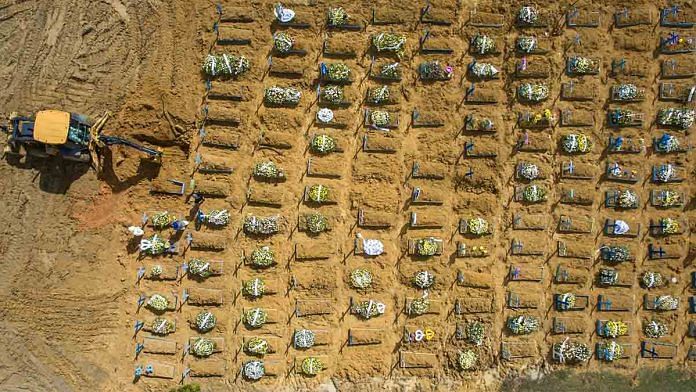Bengaluru: A second wave of Covid-19 has hit Manaus, with cases and mortality climbing rapidly in the Brazilian city. Hospitalisation rates have also increased exponentially this month.
This comes after it was believed that Manaus had achieved ‘herd immunity’. In October 2020, it recorded a very high level of seroprevalence, indicating that nearly 76 per cent of the city’s 2 million population had already been infected and developed antibodies.
After the pandemic’s peak in April last year, which was accompanied by stunning visuals of mass graves stacked with tiers of bodies, deaths and cases in the city started to fall. Hospitalisations also remained low for seven months despite relaxed mobility measures.
However, the resurgence of cases has left Manaus’ healthcare system crippled and the city was even forced to airlift oxygen after hospitals ran out of it.
A new peer-reviewed study, published in the The Lancet journal Wednesday, offers four explanations why this strong wave has resurfaced in Manaus despite perceived herd immunity.
Overestimated herd immunity
According to the researchers, an overestimation of the antibody prevalence in the city’s population could be one of the reasons for the second wave.
They note that the city saw a 52.5 per cent seroprevalence in June, and the numbers were likely adjusted a bit too steeply, to factor in waning antibodies, to arrive at 76 per cent seroprevalence in October.
However, this doesn’t explain everything, they add.
“Even this lower bound should confer important population immunity to avoid a larger outbreak,” the researchers state.
They explain mandatory exclusion of blood donors with Covid-19 symptoms may have further underestimated the true exposure of the population to the virus.
Also read: ‘She was positive’ — the test report in Kerala that started India’s Covid story a year ago
Waning immunity
Another potential reason for Manaus’ second wave was that immunity against the infection could have already begun to wane and gone down by December.
The authors note that studies have shown reinfections could occur beyond six months, which is probably what happened in Manaus.
The Brazilian city saw its maximum number of infections or its first peak in April-May 2020, and the second wave in January is at least seven to eight months later, they explain.
However, the authors point out that this explanation is incomplete as well, especially because Manaus went into stricter lockdown with more mobility restrictions from mid-November.
Immunity-evading mutations
The three newer variants of the virus — B.1.1.7, B.1.351, and P.1 — have also been attributed as a likely cause for reinfections or immunity evasion.
In one case in the city, the P.1 variant was associated with a reinfection and the variant itself originated in Manaus.
The three variants host a number of mutations, including E484K and N501K, which have been identified as being part of reinfections and have also been identified to be able to evade detection by the immune system.
Additionally, a newly identified variant P.2 has also independently evolved the E484K spike protein mutation and has been detected in many people in Manaus.
The P.2 variant with this mutation has been identified in at least two reinfection cases in Brazil.
Also read: Unlike rest of the world, India has plenty of Covid vaccines but few takers
Highly transmissible variants
The final reason that the researchers offer for the devastating second wave in Manaus is that the newer Covid variants in Brazil are highly transmissible.
Just like the B.1.1.7 and B.1.325 lineages, circulating in the UK and South Africa, have demonstrated increased transmissibility — the ability to spread, not the ability to cause a more severe infection — the P.1 lineage could be more transmissible as well.
The variant or lineage was first identified in Manaus and has also independently evolved mutations like the N501Y, K417N/T, and E484K, which also occur in the UK and South African variants that show high transmissibility.
While scientists are still attempting to understand the variant, preliminary studies have shown that the P.1 lineage was found in 13 of 31 genome samples obtained from in Manaus in December, whereas was absent in all 26 samples collected earlier between March and November.
Healthcare workers have also noted that infections with this lineage, unlike the strains in the UK and South Africa, have shown an increased severity in the disease.
While the UK variant took three months to completely dominate the outbreak in the country, experts note that P.1 took only about a month to become the most dominant variant in Manaus. The variant has since been detected in Japan and in the US as well.
Experts have also alluded to the combination of a higher transmissible variant and a lack of coordinated public health response from the Brazilian administration as a reason for the collapse of the healthcare system in the face of the second wave.
The authors of the Lancet study conclude that the new variants with higher transmissibility may have driven a spread of cases in both Manaus and elsewhere, especially if they have mutations that evade immune detection.
“Conversely,” they added, “if resurgence in Manaus is due to waning of protective immunity, then similar resurgence scenarios should be expected in other locations.”
Also read: Investors sue AstraZeneca for vaccine testing stumble that caused its stock price to drop




Brazil has one of the highest HIV infection rates on Earth. After taking this into account, the perspective on why immunity is less and deaths are higher is quite different.
When it is happening?
Why media in crisis. Reason it’s a bane on the society vested interests anti lobby support paid news insulting a particular culture and belief . No doubt either it gets regulated or wane only question of time